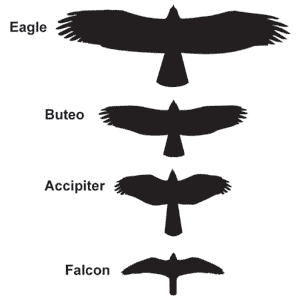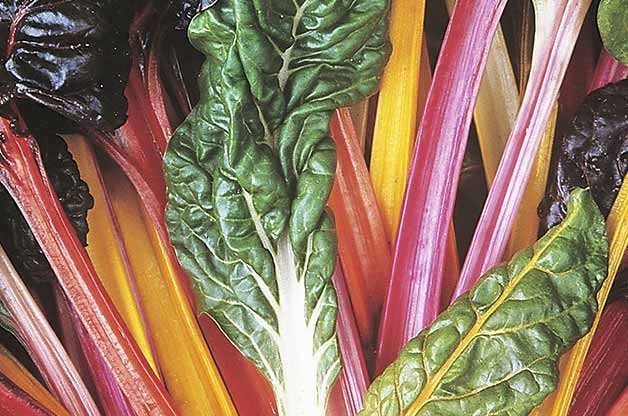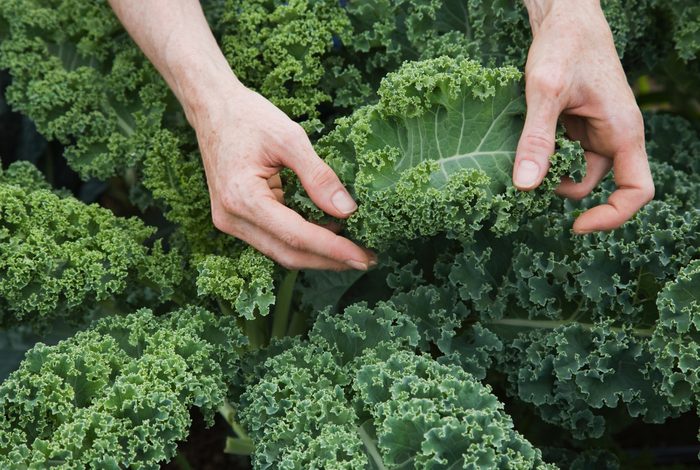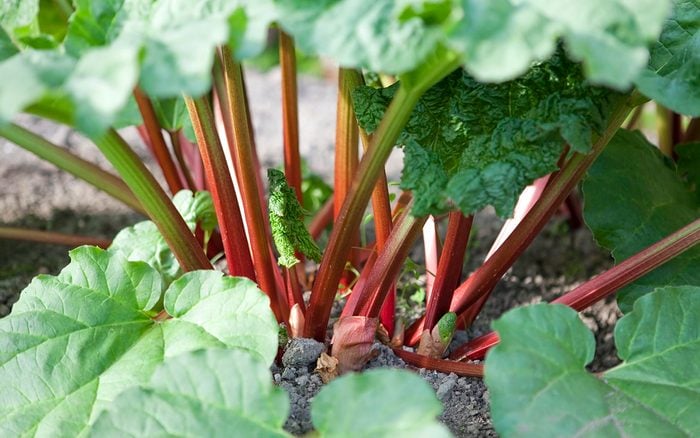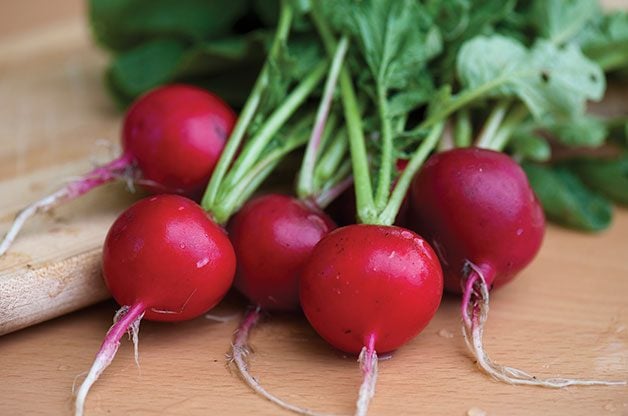The Christmas cactus is a lovely houseplant found all over the United States. This low-maintenance and pet-friendly plant is a popular choice among novice and expert gardeners, and its brilliant — usually pink — blooms delight onlookers year after year. Learning how to care for a Christmas cactus ensures that you’ll have those signature flowers when holiday guests arrive.
There are a few things you’ll need to do to help your Christmas cactus flower. When cared for correctly, these green beauties flourish indoors, growing to incredible sizes. Like many holiday houseplants, a Christmas cactus relies on lighting and temperature to bloom at the right time.
Psst—here’s how to care for poinsettias after the holidays.
Is the Christmas Cactus Actually a Cactus?
Yes, it is, but it is much different from desert cacti like the golden barrel cactus. The Christmas cactus is a tropical plant native to Brazil, so it likes more water and humidity than the average cactus houseplant. If you tend to overwater other cacti, a Christmas cactus might be a better option for you.
Why is there mold on my houseplant soil and how do I fix it?
How to Care for a Christmas Cactus: Lighting
A Christmas cactus prefers indirect light. That’s one of the reasons it is such a common indoor plant. Miracle-Gro recommends placing your Christmas cactus near a north- or east-facing window. A Christmas cactus can tolerate some direct sunlight, but be careful about placing it in the hot afternoon sun. Too much light will cause discoloration in the leaves.
If you notice burning, move it away from the window. Christmas cactus blossoms fall off easily, so try to find the right lighting during its growth season to avoid moving the plant while it flowers.
Check out the top 10 best houseplants for low light.
How to Care for a Christmas Cactus: Water
A Christmas cactus needs plenty of food and water. Plant it in well-draining potting soil, then water when the top one or two inches are dry. Use Miracle-Gro Succulent Plant Food or a similar product between blooms to fuel fresh bud growth. Adding humidity to a dry home will also help your cactus thrive, especially in the winter.
Learn how to propagate succulents (for more free plants!)
How to Make a Christmas Cactus Bloom
Colorful flowers make the Christmas cactus a showstopper, and it will bloom more than once with the proper care.
Start by planting your cactus in the right pot. If the pot is too large, you’ll have fewer flowers, so don’t size up by more than a couple inches. Don’t re-pot while it blooms or you’ll lose all the flowers. A Christmas cactus likes crowded roots, so you won’t need to re-pot very often.
Marvel at the beauty of cactus blooms with these 15 beautiful pictures of cactus flowers.
The Chicago Botanic Garden explains that a Christmas cactus’ bloom cycle depends on temperature and lighting cues. Decide when you would like your plant to flower. Start preparing eight weeks before your chosen date. For six weeks, give your plant 13 to 15 hours of darkness per day, or keep it in a cool environment at night. When you return the Christmas cactus to warmer temperatures and brighter light, flower buds will form — just in time for the holidays.
Next, learn how to grow and care for amaryllis (and make the bulbs rebloom!)
According to the Kaufman Field Guide to Birds of North America, the three species of rosy-finches (black, gray-crowned and brown-capped) have separate ranges in summer but they may overlap in winter. Rosy-finches breed in high mountain elevations throughout western North America.
Discover 7 types of finch birds to look for in winter.
Black-Crowned Rosy Finch
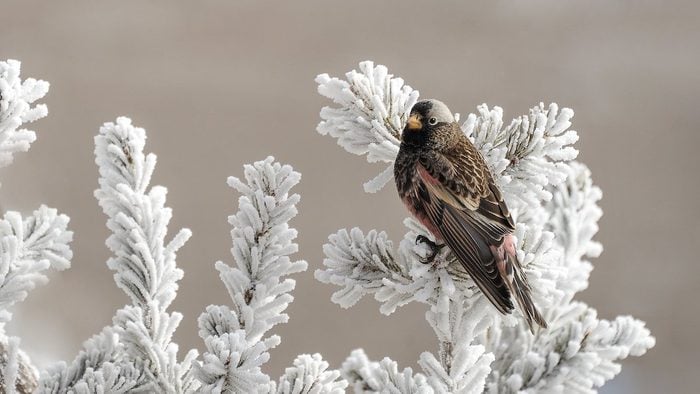
Black rosy-finches have black bodies with rosy colored bellies and wing patches. Like other finches, these birds will stop by feeders in western mountain towns. To attract black rosy-finches, fill your feeders in the late afternoon to give birds energy before chilly nights. Psst—here’s how to help birds in cold winter weather.
“On the last day of our trip to the Southwest, we stopped at Sandia Crest in New Mexico. Frost covered the landscape and birds swarmed the feeding station. A black rosy finch landed in front of us, perching on a perfectly frosted branch. I took the shot (above) just as the sun came out from the clouds. It was an ideal end to an amazing trip to the Southwest!” says Martina Nordstrand of Indian Trail, North Carolina.
Learn how to attract and identify purple finches.
Gray-Crowned Rosy Finch
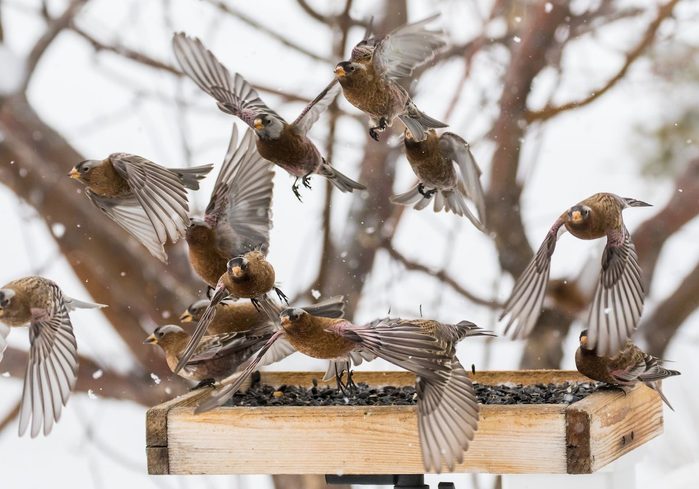
Gray-crowned rosy-finches are rugged birds that are found from Alaska to the mountaintops of northern New Mexico. They are the most widespread of the three rosy-finches. Their bodies are not as darkly colored as black rosy-finches.
In Yosemite National Park, the gray-crowned rosy-finch forages in the inhospitable, snow-laden mountains.
“Every winter we have anywhere from 200 to 400 gray-crowned rosy finches come to our backyard at the base of the Crazy Mountains north of Big Timber, Montana, to enjoy the black oil sunflower seed we provide. They are pretty friendly and provide me with hours of finch photo opportunities each winter. I was having fun trying to capture them in flight and was pleased to see the wing patterns and action in this photo (above),” says Jerrty Taylor.
Meet the 3 types of goldfinches in the United States.
Brown-Capped Rosy Finch

The brown-capped rosy finch has the most limited range of the three species. The Kaufman Field Guide range map shows this species is primarily spotted in Colorado and nearby areas.
Watch your feeders in winter for a common redpoll.
Where to Find Rosy-Finches

The Sandia Crest House in the Sandia Mountains outside of Albuquerque, New Mexico, in the Cibola National Forest, is known as one of the best sites for birders to see all three species of rosy-finches during their non-breeding season, from early winter to early spring.
“It was very exciting to see great numbers of rosy-finches hanging around the feeders at the Crest House. I happened to catch this black rosy finch (above) stretching its wing out in a very unique pose. The snow-filled branches in the background bring out the colors of this beautiful bird!” says Gary Botell.
Next, learn how to tell the difference between a pine siskin vs a goldfinch.
As winter approaches, snowflakes aren’t the only things swirling around your feeders. Pine siskins sometimes fly in as they migrate from high mountains of the west and Canada’s conifer forests to America’s Lower 48 looking for food. Here’s how to identify and attract a pine siskin.
Wondering if you’ll see lots of pine siskins in your yard this year? Check out the updated winter finch forecast.
What Does a Pine Siskin Look Like?

Looking similar to a sparrow but in the finch family, pine siskins have small, slender bodies that are streaky brown all over, and especially on the chest. Bright yellow markings edge their wing tips and tails, distinguishing them from house finches. Look for flashes of yellow as a pine siskin flutters from branch to branch, sometimes hanging upside down, picking seeds from pine cones or descending upon a field of thistle or wild sunflower.
Pine siskins’ pointed bills are thinner than those of other common finches. Long wings extend toward the tips of their tails. Their notched tails are easy to see in flight. These birds are 5 inches long with a wingspan of 9 inches.
Adaptable to survive cold weather and full of acrobatic antics in flight and while feeding, they are special songbirds that many birders hope to see.
Pine siskin vs goldfinch: Here’s how to tell the difference.
Pine Siskin Song

These social birds travel in large, noisy flocks that are difficult to miss. Though a single pine siskin sometimes appears in flocks of goldfinches, their close relatives. You’ll probably hear their raspy, wheezy twitters before you even see them. Canary-like calls range from a tuneful “sweeet” to a harsh rising “zzzzz” sound.
Bird songs provided by the Cornell Lab of Ornithology.
Meet the 3 types of goldfinches in the United States.
Nest and Eggs
The female pine siskin builds a shallow nest of twigs and grasses, lined with fur or feathers and lays three to five pale green-blue eggs inside.
What Do Pine Siskins Eat?
Look for these social birds flitting around thistle feeders in busy flocks. To get up close and personal with these winter visitors, simply set out their favorite food, and these opportunistic eaters will find you–and fast!
Like nearly all finches, a pine siskin’s diet consists mostly of seed, though they also eat insects such as caterpillars and aphids. In the wild, pine, spruce, alder, birch, grass, sunflower and weed seeds are their go-to foods. But in the backyard, fresh Nyjer seed (also called thistle) is a safe bet, as are black-oil sunflower seeds, millet and sunflower chips. Just be sure to have plenty on hand to keep them coming back. Pine siskins also occasionally eat suet, especially insect-based kinds.
Don’t miss super pretty pictures of finches.
The Best Feeders for Pine Siskin Birds
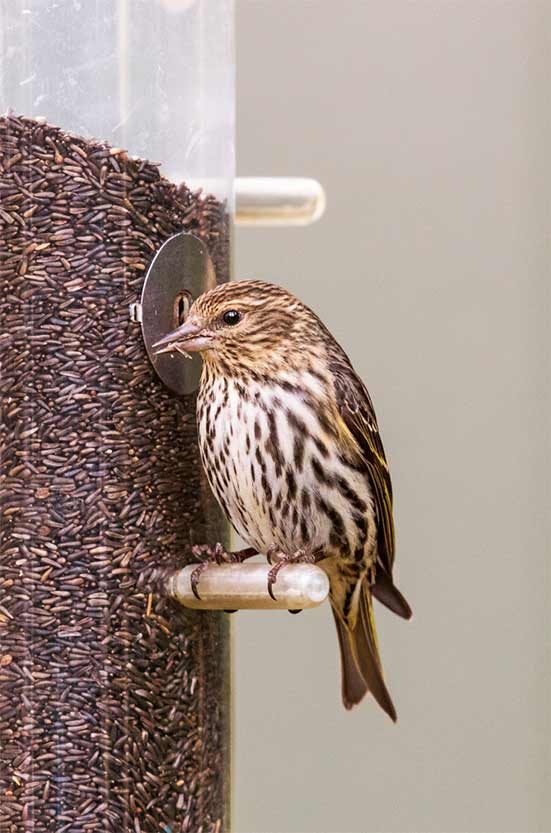
Because siskins are likely to feed by the dozens, long tube feeders that offer several perches allow for many to feast at once. And it’s best to set out multiple finch feeders because pine siskins are a feisty and sometimes combative sort when it comes to food. You also may find success by spreading seed on the ground.
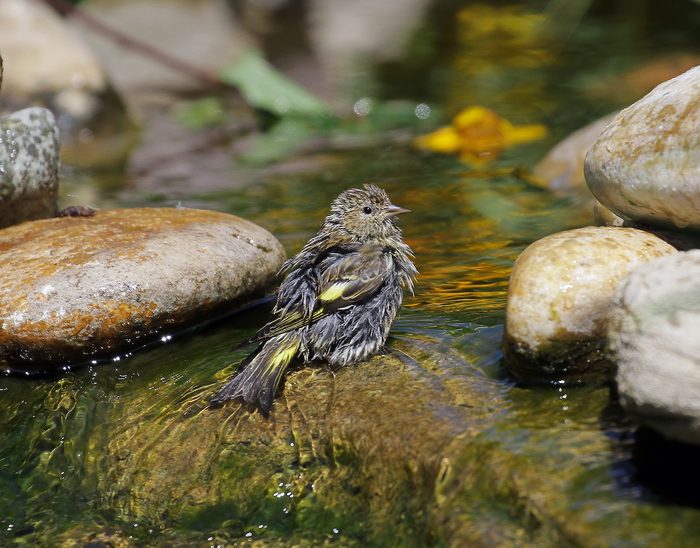
Pine siskins also love to bathe in bunches. Here’s how to keep your bird bath thawed in winter:
- Invest in a birdbath heater or de-icer.
- Put water in a heated dog dish.
- Add a small fountain to keep the water moving.
- Pour hot water over icy birdbaths in the morning to loosen ice, then fill with warm water.
Pine Siskin Salmonella
Unfortunately, pine siskins are susceptible to salmonella, which is easily transmitted from one bird to another as they travel and eat in tight groups. This happens in the wild, however, as much as it does at backyard feeders. Keep bird feeders clean to help prevent or slow the spread of the disease.
Learn more about common wild bird diseases.
Pine Siskin Range Map and Habitat
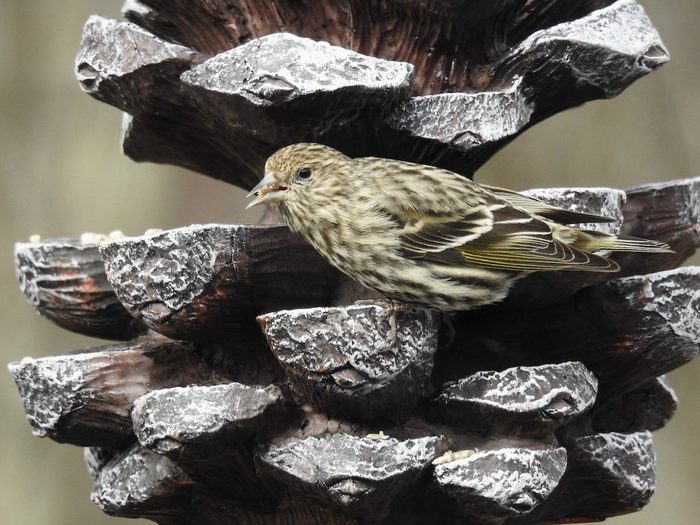
Although pine siskins call part of the west home year-round, these birds are winter visitors in most of the U.S., flying in after breeding season. They are often spotted in backyards and coniferous forests.
But their journey southward isn’t a sure thing. It’s common for birders to see pine siskins in droves one year, then nothing the next. These sporadic and geographically erratic visits are most likely prompted by a cyclical shortage of conifer seeds.
“This past winter; I was thrilled to have a large (over 150) flock of pine siskins stay by my feeders daily. Their favorite was this pine cone feeder (above). I added shelled sunflower seeds, which seemed to keep them coming. I hope they return next winter!” says Birds & Blooms contributor Nancy Tully.
Mimic their habitat to attract pine siskins. Place feeders near twiggy trees, large conifers and other dense winter vegetation so the birds have a place to go for winter shelter against the predators, snow, wind and sleet that often come with the season. Along a tree line or woody area is ideal.
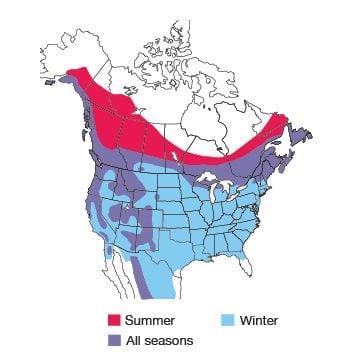
Next learn how to identify common redpolls, a cheery, hardy winter bird.
Range maps provided by Kaufman Field Guides, the official field guide of Birds & Blooms.
When was the last time you added a new feeder to your backyard? Or put out a special treat for the birds? Even if you’ve been feeding backyard birds for years, there are probably a few things you haven’t tried yet. And adding new things is the best way to attract a wider variety of species to your space. Give one of these fun food options a try and see what you can attract.
Psst—check out 9 foods you should never feed to birds.
Peanut Butter

I know many folks who have stopped buying suet cakes and now make their own, with peanut butter as the base. Others have made the switch from feeding peanuts, either in or out of the shell, to offering peanut butter instead. You can stuff the holes of a log feeder with peanut butter or even just smear it on tree bark. Woodpeckers and blue jays relish peanut butter snacks. You can also put it out for species like nuthatches that will store caches of peanuts but would be hard-pressed to stock up on jars of peanut butter!
Jelly

What goes better with peanut butter than jelly? Grape jelly is becoming a go-to offering for orioles. Gray catbirds and red-bellied woodpeckers are among the other species that can’t resist the sweet, fruity stuff. You can buy a special jelly feeder, but any shallow container will also do the trick. Learn how to attract orioles and tanagers with jelly
Fruit

Many lodges in the tropics offer fruit to draw birds in for close viewing. Tanagers are keen on these fruit feeding stations, and some folks who live farther north have been fortunate enough to lure the brilliantly colored western, summer and scarlet tanagers to their own backyards. Orioles love orange halves; when they’ve eaten the fruit, fill the empty peels with jelly. Also try putting out berries or raisins, or experiment with any fruit you happen to have. You just might attract mockingbirds or robins.
Birds That Like to Eat Oranges

- Gray catbirds
- Red-bellied woodpeckers
- Northern mockingbirds
- Brown thrashers
- Orioles
- Tanagers
- Rose-breasted grosbeaks
Butterflies flock to fruit, too. I’ve used a window feeder to offer apples and bananas and had great success attracting these pretty fliers.
Mealworms

Try adding some mealworms to your buffet. Some people have success with oven-roasted worms, while others swear by the live ones. I keep a container of the latter in my refrigerator door, and the only real maintenance is to toss in a carrot for them once in a while (they need to eat, too!). Mealworm feeders need to be a couple of inches deep so the worms won’t crawl out. Although it might take the birds a while to find your mealworms, once they do, they’ll be hooked. Mealworms are like candy to them. I offer a dozen or so at a time. The birds will quickly train you to feed them on a regular schedule by scolding you when you slack off.
Mealworms appeal to a wide range of birds, including some species that don’t usually come to traditional feeders. Some of the most common are bluebirds and robins.
Roasted Seeds

Plenty of birds are seedeaters, but think beyond the usual sunflower seed and safflower seed varieties. Try roasting pumpkin or squash seeds; you can bake up a batch, share half with the birds, plain, and season the other half to your own liking. Then you’ll be snacking right along with the birds that you’re watching. Northern cardinals, sparrows and other seed specialists will especially enjoy the variety.
Baked Eggshells

These provide calcium, which can be especially important for females during nesting season. But it’s essential that you wash and bake the shells to kill off any potential pathogens. You wouldn’t want to give your feathered guests food poisoning or something even worse. After you bake the eggshells, crush them and add them to your seed, or just sprinkle them on the ground. You can also offer them in a platform feeder.
Compost

When I was growing up, my grandpa had the biggest compost pile ever. I remember hauling out the scraps in an old ice cream bucket and tossing them on the pile. I also remember that black-billed magpies were always eager to greet me at the pile. Just remember that your compost pile is fair game for other critters, too. I could always count on spotting a raccoon on my grandpa’s after dark.
Stale Nuts
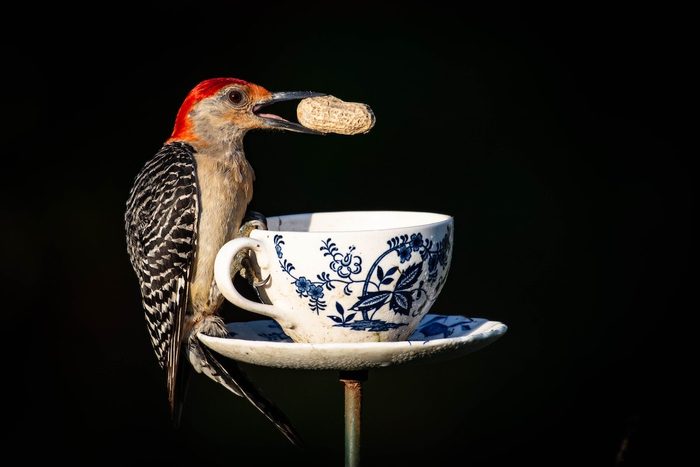
It seems like there are always some leftover nuts around, especially during the holidays. If you’ve got unsalted nuts that are past their prime, put them out and see which birds will take a bite. Here’s how to attract more backyard birds by feeding peanuts.
Plants

This one might sound obvious, but its importance can’t be overstated. One of the best ways to diversify your backyard feeding station is to garden for birds. (And not just nectar flowers for the hummingbirds.) Plant some native berries or fruit trees, or let your flowers go to seed, and you’ll reap the avian rewards in all seasons.
Learn how to attract birds with coneflowers.
Suet

Traditional suet is made of beef fat, but Birds & Blooms hears frequently from readers who rave about their homemade suet recipes. Some use lard, peanut butter, raisins and birdseed to make homemade suet cakes. So experiment with the foods mentioned above and see what tasty bird treat you can come up with!
The Least Picky Eaters
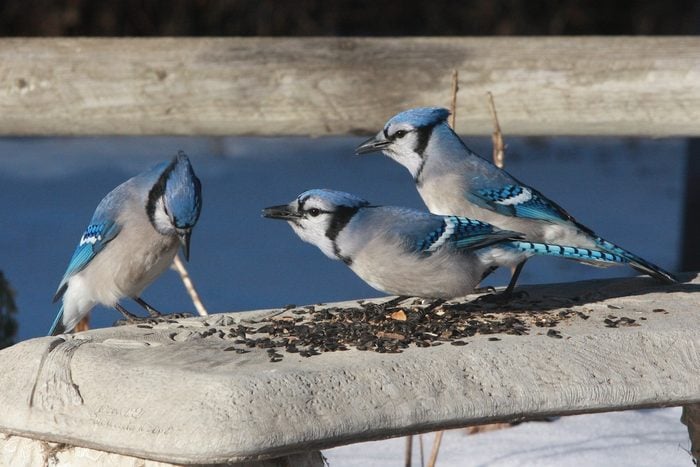
No matter what you’re serving, these birds will eat it.
- Blue jays will eat just about anything and are not bashful about it.
- Red-bellied woodpeckers are known for munching on seed, suet, fruit, mealworms and many other offerings.
- Grackles are not just less picky eaters, they’re also some of the messiest.
Walking into a pine grove, you hear soft, unfamiliar calls overhead. Looking up, you see a dozen small birds clambering about over the pine cones, acting like tiny parrots. Some are red, some are dull yellow-green. Take a good look. These are crossbill birds, and they may stay put for a month or may be 100 miles away tomorrow.
Meet 7 types of finch birds to look for in winter.
Types of Crossbill Birds
Two species, red crossbills and white winged crossbills, are widespread in North America. And they’re among the world’s most unusual birds. Wandering flocks of white winged or red crossbills may show up far from evergreen forests, especially in winter. Occasionally they visit bird feeders for sunflower seeds. But you’re much more likely to see them in groves of conifers, such as in parks or cemeteries. If you find a flock, count yourself lucky to meet the ultimate nomads of the bird world.
Watch your feeders for common redpolls this winter.
White Winged Crossbill

Overall ranges of the two species overlap, but white-winged crossbills are mainly farther north, in spruce forests across Alaska, Canada and the northernmost states. This bird that isn’t a common visitor to feeders. They are great nomads, migrating at almost any season, and settling down to nest and raise young when they find an abundant crop of spruce cones. When crossbills leave your yard, they may go in any direction. You may see them again, but they’re so unpredictable that we can’t guess when they might arrive!
Meet the rosy finch (and learn the best place to see one).
Red Crossbill

Red crossbills occur from southern Alaska across Canada and the northern states, farther south in the Appalachians, and in the western mountains, with other populations in the mountains of Mexico and Central America. There’s one unique thing about the red crossbill: It can be divided into 10 types in North America. These are not subspecies but groups separated by slightly different voices and by preference for certain trees.
For example, Type 1, found mainly in the Appalachians, has a short callnote and prefers red spruce and eastern white pine seeds. Type 2, widespread in the Rocky Mountains, has a deep, husky callnote and prefers the seeds of ponderosa pine. Type 3, common in the Pacific Northwest but wandering widely, has a squeaky callnote and prefers hemlock seeds. All of them wander widely across the continent, often overlapping but rarely interbreeding. Scientists are still trying to figure out if some of them should be classified as distinct species.
Check out the updated winter finch forecast for 2021-22.
Cassia Crossbill

Southern Idaho has its very own bird that is not found anywhere else in the world. The Cassia crossbill looks very much like a red crossbill, and it wasn’t officially recognized as a separate species until 2017.
Although its relatives wander far and wide, the Cassia crossbill doesn’t stray from the lodgepole pine forests of Idaho’s South Hills and Albion Mountains. Why? Because the two areas have no red squirrels. In most places, lodgepole pine cones are quickly stripped of seeds by red squirrels. The crossbills grab whatever seeds they can in an area and then move on. But in these two isolated mountain ranges where there is no competition from squirrels, Cassia crossbills dine on those seeds all year without having to fly away in search of more.
Check out more birds you can only see in one place on Earth.
Crossbill Bird Beak

When you look at a crossbill’s beak, it’s obvious how it got its name. The bill is thick at the base, but the mandibles cross instead of meeting at their narrow tips. This shape would be awkward for picking up most items, but it’s perfect for one thing. It allows the birds to pry open the cones of pines, spruces, hemlocks and other evergreens.
For most small birds, getting seeds out of a cone is too complicated to be worth the effort. For crossbills, it’s a snap. The bird inserts its beak between two cone scales and then closes it so that the crossed tips push the scales apart. Twisting its head, the bird works to reach the seed buried between the scales. Using its tongue against grooves on the inside of its beak, it pulls out the seed, cracks the dry husk and swallows the kernel.
This happens in a lot less time than it takes to describe it. A crossbill can extract and eat more than 20 seeds per minute, which means better than one every three seconds!
Learn about the different types of bird beaks and how birds use them to eat.
Nomadic Behavior and Nesting

When conifers are loaded with cones, these birds have an easy food source. But big cone crops don’t last and are extremely variable from year to year, so crossbills move until they find the next good food supply. In any given forest, crossbills might be abundant one year and completely absent the next.
In most kinds of birds, each male has a regular nesting territory and returns to it the same time every year to pair up and raise a brood of young. Crossbills throw those rules out the window. When a roving flock comes to a forest where lots of cones are ripening, they settle in, build nests and lay eggs.

After the young birds are old enough to fly, if the seed supply is starting to run out, the flock may move on. Those particular birds might never visit the place again after food runs out. Crossbills don’t follow the guidelines of a calendar or a map. They raise young at almost any time of year, whenever they find a good cone crop. For example, in one area of eastern Canada, white-winged crossbills have been found nesting at four different times in one year—in February, April, July and September—feeding on seeds of three different kinds of spruce.
Learn more about bird irruptions and how birds migrate unpredictably.

While I was at the Cape May Autumn Birding Festival, there was major chatter about a Swainson’s hawk spotted in the area, which excited all of us birders! But as I wondering how the heck people knew what it looked like and was planning which field trips to attend on Saturday, I came across the description of a hawk identification workshop. It said, “Struggling to separate a sharp-shinned hawk from a Cooper’s? Amazed when a bald eagle is spotted high in the sky where you see nothing?” YES and YES, I thought!

Unfortunately for us, birds of prey don’t usually strike a lovely pose like this American kestrel (above), giving us the opportunity to make an identification at eye level. You can’t really rely on field marks, colors and size when you’re looking at the bright sky and the birds are SO far away. Here are a few hawk identification tips I learned at the workshop.
On This Page
Hawk ID Tips
1. Wing Shape
Look at the chart above to help you with hawk identification in flight. The shape of the wings can offer cues to which family your raptor is in. Accipiter wings have a rounded or pointy shape. And the buteos’ wings are straight and quite broad.
2. Tail Shape and Length

In addition to the wings, the tail can also help with hawk identification in flight. On the chart, look how short and stubby the tail of the buteos are, compared to the longer and rounded tail of accipiters.
Here’s how to identify a red-tailed hawk.
3. Wing Feathers

If you’re unsure if you’re looking at a falcon, look for the LACK of fringed feathers at the edge of the wings on the hawk identification chart. Eagles, buteos and accipiters have them, making the wing look almost like a hand.
Learn all about bird wings and flight feathers. While you’re at it, here’s how to tell the difference between falcons and hawks.
4. Bird Shape in Flight

Having trouble deciding between the accipiters? A Cooper’s hawk looks like a “flying cross” (a larger head, rounded tail) and a sharp-shinned hawk looks like a “flying capital T” (a small head).
5. Rump Patch

A Northern harrier bird has a very distinguishable, and commonly seen from the field, white rump patch. It’s large enough that you can actually see it as the bird is flying over head. This is a good way to identify northern harriers quickly.
Check out 8 must-visit hawk migration hotspots.
Common Types of Hawks and Falcons
Eagles
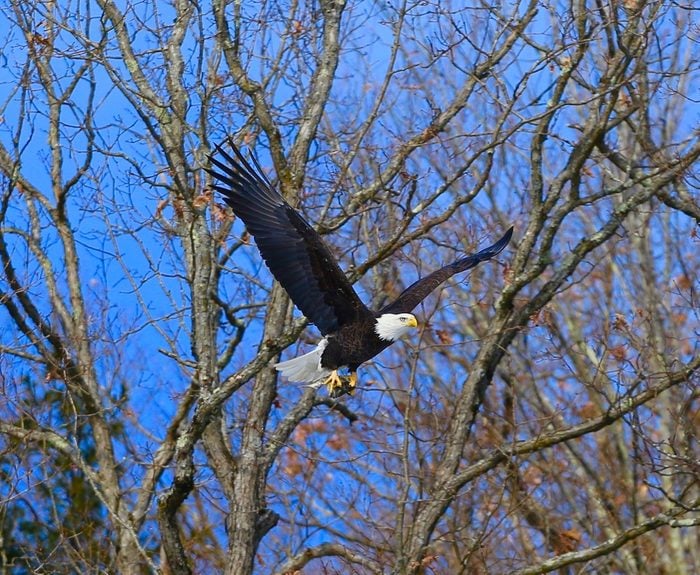
North America is home to two species of eagles: bald and golden. Check out their expansive wings and their ability to soar. They’re hunters and scavengers, feeding on fish, small animals and carrion. Eagles’ extremely large wingspans can reach up to 7 feet or more.
Accipiters and Buteos

Many accipiters and buteos are widespread across the U.S. and are comfortable visiting backyards in search of a meal. Accipiters include the sharp-shinned hawk, Cooper’s hawk and northern goshawk. Buteos include the red-tailed hawk, rough-legged hawk, broad-winged hawk and red-shouldered hawk.
Falcons

These birds have a need for speed; some species can exceed 200 mph in flight. Falcons come in a variety of sizes—the tiny American kestrel is only 10 inches long. Be on the lookout for an extra-long hook in their beaks, known as a tomial tooth, which is used to rip their food. Other falcons include merlins and peregrine falcons.
Discover the fastest birds in North America.
Ospreys
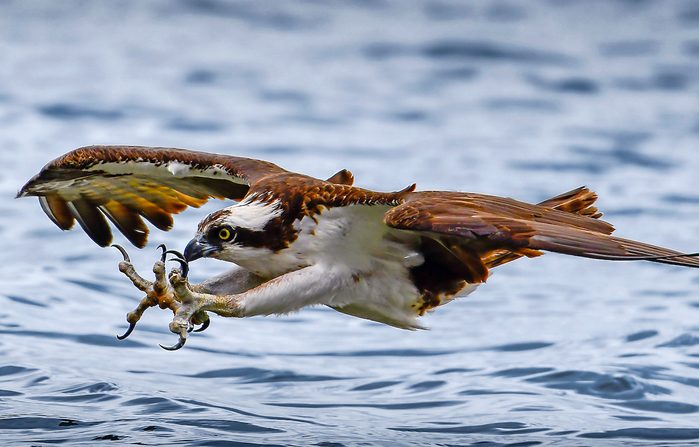
Ospreys are classified in a different family from all other raptors. Often mistaken for bald eagles because of their size and coloring, they eat solely live fish. They dive feet-first into the water in pursuit of food, and sometimes even fully submerge themselves.
Next, discover the amazing types of owls in North America.

How to Tell the Difference: Pine Siskin vs Goldfinch
Goldfinches and pine siskins often flock together and share similar characteristics. But the trick to identification for a pine siskin vs goldfinch is to look for the sparrowy streaks on the pine siskin’s cream colored breast.

American goldfinches do not have these streaks. You may spot flashes of goldfinch-like yellow as pine siskins flutter from branch to branch, sometimes hanging upside down, picking seeds from pine cones or wild sunflowers. Add a sharp, slender bill to the finchlike size and shape, and you’ve got a pine siskin.
Learn how to attract more goldfinches to your backyard.
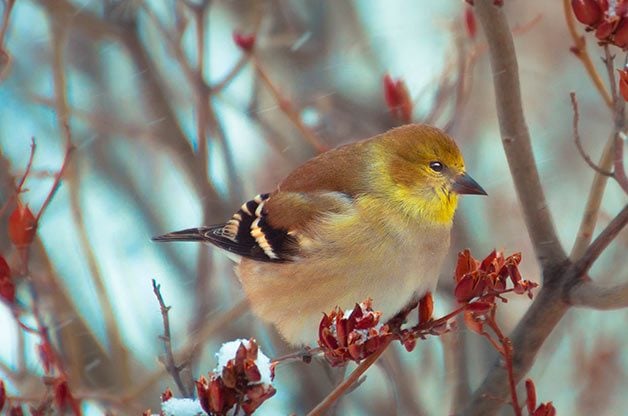
In spring and summer, male American goldfinches are vibrant yellow birds that clearly stand out in the backyard. Females are a duller yellow color. However, in winter, the male goldfinches molt from summer gold to winter brown plumage, making it a bit more tricky to identify them. Flocks of winter finches often include a few pine siskins and sometimes even common redpolls, so scan those groups closely!
Meet the 3 types of goldfinches in the United States.

Pine Siskin vs Sparrow
I saw this bird (above) in late May. What is it, and was it just passing through? Heather McIlravey of Severn Bridge, Ontario.
Kenn and Kimberly: That visitor is a pine siskin. Pine siskins look similar to sparrows but are in the finch family. Its streaky brown appearance might suggest a sparrow, but this species is actually a close relative of the goldfinches. You could think of it as a goldfinch in camouflage. The fine dark streaks on its sides, the relatively plain face, and the narrow, sharply pointed bill are all helpful ID marks. A few pine siskins may stay through the summer in your part of Ontario, but most go a little farther north. American goldfinches are common in backyards all year round. Whether they’re staying or just passing through, both of these birds will come to finch feeders for thistle (Nyjer) seeds.
Next, check out 7 types of finch birds to look for in winter, and learn where you can find a rosy finch.
Some vegetables prefer cooler temperatures, making them perfect for springtime gardens. Start seeds in late winter and be prepared to set plants out as soon as the soil is warm enough, and you’ll enjoy the first spring vegetables and fruits of your labor before summer even arrives!
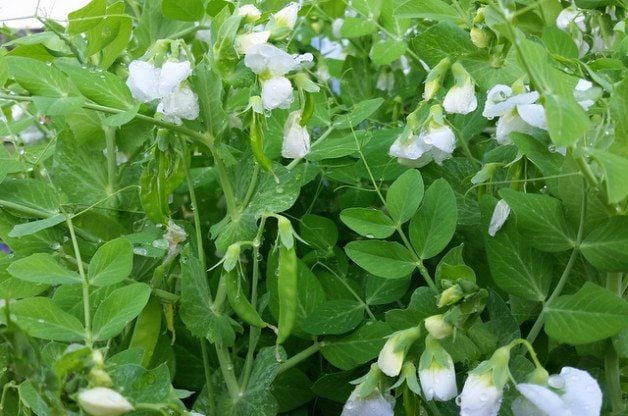
Peas
Pisum sativum
There are two basic kinds of peas: garden peas, which require shelling, and snow or sugar peas, which yield edible pods. No matter which you prefer, eat ’em with gusto, as these little spring vegetables are an excellent source of iron, protein, vitamin C and soluble fiber. Pass the peas, please!
Planting Advice: When soil is workable (near the end of March in cold climates), sow seeds 1 to 2 inches deep and 4 inches apart; 18 inches between rows.
Harvest Tips: Peas generally mature in 54 to 72 days, depending on the variety. Younger peas taste sweeter than more mature peas. Harvest garden peas when the seeds are visible, but before they get too big and the weather gets too hot. Pick edible-pod peas before the seeds fully develop. Use two hands: one on the vine, the other to pick the peas. Regular picking encourages continued pod production.
Top picks: Snowflake, Daybreak (early), Wando (summer)
Tasty Heirlooms: Amish Snap, Blue Podded, Golden Sweet, Green Arrow, Sutton’s Harbinger
Check out 10 seed catalogs every gardener needs.
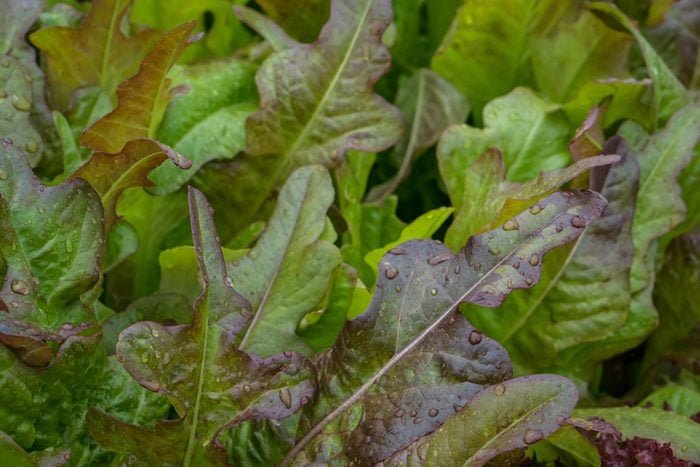
Lettuce
Lactuca sativa
Versatile lettuce is easy to grow, yields a bumper crop in small spaces and is largely pest- and disease-resistant. Plus, the yellow, bronze, pink and cherry-red varieties make great ornamentals—and add color to salads. What’s not to like?
Planting Advice: Around two weeks before the last frost, plant seeds in full sun or partial shade, 1/4 to 1/2 inch deep and 2 inches apart in fertile, well-draining soil. Thin seedlings to 12 inches apart. For a fall or early-winter harvest, sow seeds every two weeks, starting at least eight weeks before the first frost.
Harvest Tips: Ready to pick in 40 to 85 days. Use quickly; lettuce doesn’t keep long.
Top Picks: Buttercrunch, Green Ice, Little Caesar (Romaine).
Tasty Heirlooms: Amish Deer Tongue, Grandpa Admire’s, Gold Rush, Red Leprechaun, Susan’s Red Bibb, Yugoslavian Red
Learn how to make newspaper pots for starting seeds.
Kohlrabi
Brassica oleracea
There’s no polite way to say this: With its bulbous above-ground stem and spoke-like arms, kohlrabi looks a bit, well, odd—like a garden alien. But follow Mom’s advice and don’t judge this ugly duckling of the cabbage family by its outward appearance. Instead, focus on these spring vegetables’ pleasantly mild, sweet flavor, which lends itself to stir-fry, soups and stews, and its nutritional content, which includes vitamin C and potassium.
Planting Advice: About a month before the last expected frost, sow seeds in full sun and well-draining soil, 1/2 inch deep and 3 inches apart. Thin seedlings to 6 inches apart. Kohlrabies can withstand a bit of frost. For fall harvest, plant seeds about eight to 10 weeks before last typical frost date.
Harvest Tips: Most kohlrabi varieties mature in six to seven weeks, and taste best when bulbs are smaller—2 to 4 inches in diameter. Bigger bulbs tend to get woody and develop an off flavor.
Top Picks: For white stems, Express Forcer, Kolpack and Triumph. For purple, Blaro and Rapid.
Tasty Heirlooms: Delicatesse Blue, Delicatesse White, Early Purple Vienna, Early White Vienna
We found the top 10 vegetables that grow well in shade. Plus, discover how to store vegetables so they stay fresh longer.
Chard
Beta vulgaris subsp. cicla
Great taste and nutritional value. Prolific production. Low maintenance and high resistance to disease. Grows in shade and poor soil. Doubles as an ornamental, thanks to colorful leaves. Yup, chard definitely is the Swiss army knife of spring vegetables. (It’s also known as Swiss chard, but it’s not native to Switzerland.) Chard tastes amazing when sauteed in olive oil with garlic.
Planting Advice: About a week or two before the last-frost date, plant seeds (which actually are more like dried fruits that hold several seeds each) 1/2 to 3/4 inch deep, about eight to 10 seeds per foot. Thin seedlings so they’re 4 to 6 inches apart. A second planting is possible in late summer. Keep in mind that red-stemmed varieties are more likely to bolt.
Harvest Tips: When the outer leaves are 6 to 8 inches tall, cut them off about 11/2 inches above the ground; younger leaves pack more flavor. Don’t nick the terminal bud in the center.
Top Picks: Bright Lights (multicolored stems), Burgundy, Perpetual (white).
Tasty Heirlooms: Fordhook Giant, Lucullus, Oriole, Rainbow, Ruby Red
Psst—your gardening friends will love these 15 harvest-themed gifts.
Kale
Brassica oleracea
Kale is an unsung veggie-garden hero. This cabbage relative not only provides calcium, iron, potassium, cancer-fighting antioxidants and vitamins A, B and C, it also offers a sweet, earthy flavor. And cooler temps prompt kale to turn stored starch into sugars, which makes it taste even sweeter. It’s even OK to harvest it after it snows!
Planting Advice: When soil is workable, sow seeds 1/4 to 1/2 inch deep in full sun or partial shade, 4 inches apart. Or start seeds indoors six to eight weeks before last-frost date; set transplants two weeks before last-expected frost. When seedlings are 2 inches tall, thin to 8 or 12 inches apart. In fall, plant more seeds eight weeks before first-frost date.
Harvest Tips: To boost yield, harvest outer leaves when 8 to 10 inches tall. Or pick the whole head when plant is 10 to 12 inches tall.
Top Picks: Redbor, Winterbor, Blue Curled Vates
Tasty Heirlooms: Dwarf Blue Curled, Lacinato, Red Russian
Follow these tips for saving tomato and veggie seeds from your harvest.
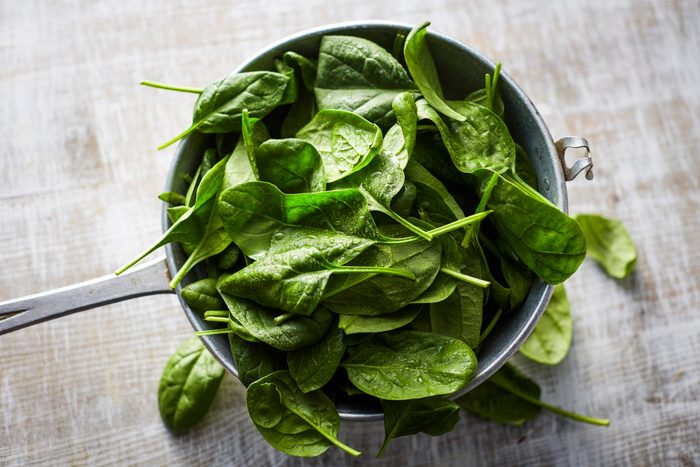
Spinach
Spinacia oleracea
Science has confirmed what Popeye knew all along: Spinach is good for you. Along with megadoses of vitamins A and K, plus folate, manganese, magnesium and iron, spinach includes flavonoids that can help fight certain cancers.
Planting Advice: Spinach thrives in cooler weather, so plant these spring vegetables in early spring as soon as soil is workable. Sow about a dozen seeds per foot about 1/2 inch deep, with about 1 foot between rows. Thin to 2 to 4 inches apart when seedlings are 1 inch tall. For an extended harvest, plant successive batches
for several more weeks. For late summer or fall plantings, chill seeds in a refrigerator for one or two weeks before sowing.
Harvest Tips: Matures in 39 to 48 days, depending on variety. Cut off leaves at ground level when they reach desired size; younger leaves taste better. When seed stalks form, harvest the rest of the crop.
Top Picks: Vienna, Giant Nobel (plain leaf), Indian Summer
Tasty Heirlooms: America, Bloomsdale, New Zealand, Red Malabar, Strawberry
Eager to start eating your veggies? Try these 10 fast-growing vegetables you can harvest quickly.
Asparagus
Asparagus officinalis
Afraid to grow these finicky bad boys? Don’t be. It’s easier than you think, and a smart budget move, since asparagus is expensive.
Planting Advice: Soak year-old crowns briefly in lukewarm water, then plant in well-draining soil when ground is workable. Dig a 6-inch-deep, 12- to 18-inch-wide trench. Create a small mound along the middle. Plant crowns atop the mound, with roots draped over the sides, about 12 to 18 inches apart, with rows 3 to 4 feet apart. Then bury the crowns 2 inches deep.
Harvest Tips: Asparagus plants take at least a year to get established, so don’t expect a first-season harvest; only lightly harvest in spring of second year. Cut spears at ground when they’re pencil-thick, or about 8 inches tall. Store ’em like cut flowers—upright in a container filled with an inch of water.
Top Picks: Jersey Giant, Jersey Prince, Viking KBC, Jersey Knight
Tasty Heirlooms: Conovers Colossal, Mary Washington, Precoce d’Argenteuil
Save time with 10 perennial vegetables that grow back each year.
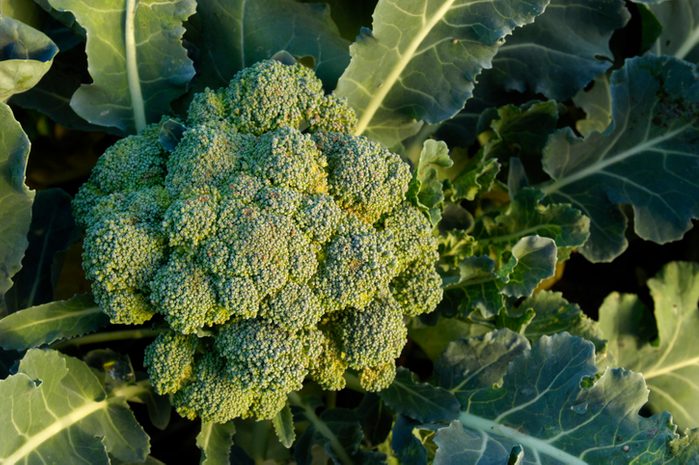
Broccoli
Brassica oleracea italica
Italian immigrants brought broccoli to America in the early 1800s, and gardens haven’t been the same since. And that’s a good thing. Broccoli contains vitamin C and beta-carotene, and is a good source of protein and fiber. Mangia!
Planting Advice: Start seeds indoors five to seven weeks before last frost. Three weeks before last frost, transplant seedlings 18 inches apart, planted a little deeper than they were indoors. Or sow seeds directly, just before the last frost, 1/4 to 1/2 inch deep and 18 inches apart. Space rows 36 inches apart.
Harvest Tips: Ready to harvest in 55 to 60 days, when the central head is 4 to 6 inches in diameter. Don’t wait too long, or florets will flower. Broccoli keeps in the fridge for a couple of weeks in airtight plastic bags. To freeze, cut the head into bite-sized chunks; leave a little stem on each piece. Cut stems into 1-inch lengths. Blanch for 3 minutes in boiling water, then dunk in ice-cold water for 3 minutes. Drain; store in airtight freezer bags for up to six months.
Top Picks: Green Comet, Green Goliath, Cruiser (drought-tolerant).
Tasty Heirlooms: Romanesco (bright-green whorled head), Calabrese, DeCicco
Make the growing season last longer with the top 10 fall vegetables to extend the harvest.
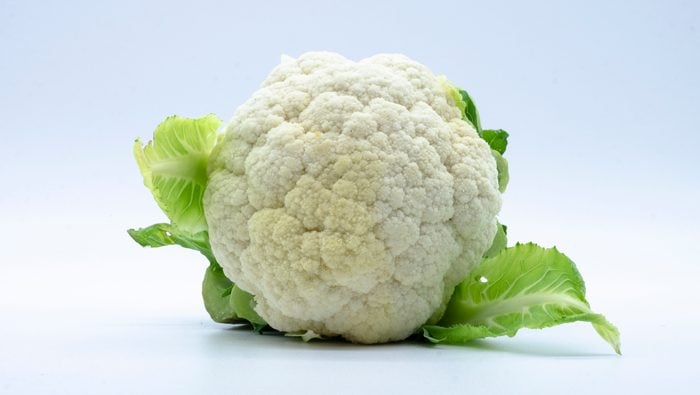
Cauliflower
Brassica oleracea var. botrytis
What kind of flower did Lassie wear to the doggie ball? A cauliflower! Jokes aside, these spring vegetables pack some serious health benefits—cauliflower helps fight heart disease and several kinds of cancer.
Planting Advice: Transplants work best. Plant seeds indoors 1/4 inch deep, five or six weeks before the last-frost date. About two weeks before the last frost, plant hardened-off seedlings in direct sun, 18 to 24 inches apart. For fall crop, start seeds 75 days before the first-frost date. To help the heads (curds) turn white and boost flavor, many varieties need blanching; loosely tie leaves around the heads when they’re egg-sized. Or buy self-blanching varieties.
Harvest Tips: Pick when curds are 6 inches across, white and firm (about seven to 12 days after blanching), with some outer leaves and 1 to 2 inches of stem attached.
Top Picks: Violet Queen (purple), Snow Crown (early), Andes (self-blanching).
Tasty Heirlooms: Early Snowball (self-blanching), Purple Cape
New at vegetable gardening? Try the top 10 easy-to-grow vegetables.

Brussels Sprouts
Brussels sprouts are tasty. Honest! As a kid, Mom probably force-fed you store-bought, overcooked and mushy sprouts. But when homegrown and properly prepared, these veggies are a nutty-tasting, full-flavored delight—and packed with vitamins and minerals.
Planting Advice: Sow seeds indoors four to six weeks before transplanting seedlings, about 90 to 100 days before the first expected fall frost. Plant these spring vegetables in full sun and well-draining soil, 2 to 3 feet apart, in rows 2 feet apart. Or sow seeds in the garden—about five seeds per foot, 1/4 inch deep—120 days before the first expected frost. When the seedlings are 4 or 5 inches tall, thin them to 2 feet apart. The plants will grow about 3 feet tall and produce 20 to 40 sprouts along each stem.
Harvest Tips: Pick in about 90 days, when the sprouts are firm and 1 inch in diameter, and before leaves turn yellow. Sprouts keep in the fridge for about 10 days in a refrigerated airtight bag, and up to a year if frozen.
Top Picks: Bubbles, Oliver, Royal Marvel, Rubine (red sprouts), Valiant.
Tasty Heirlooms: Falstaff (purple-red leaves), Long Island Improved
Snow won’t stop? Check out 10 winter garden ideas to keep green thumbs happy.
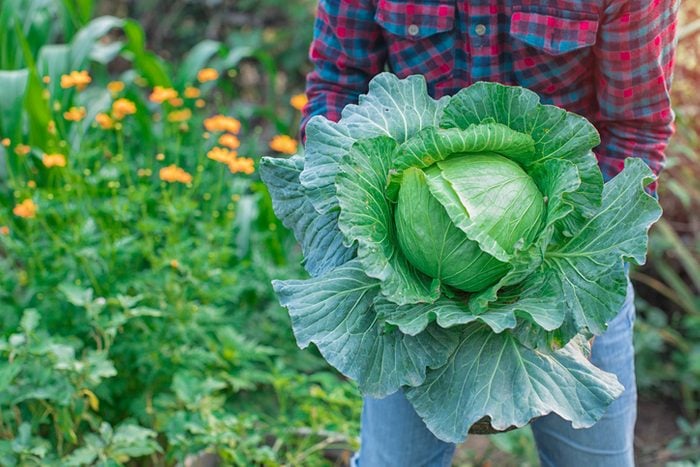
Cabbage
Brassica oleracea var. capitata
From coleslaw to sauerkraut, cabbage has clout. A member of the same family that brings you broccoli and brussels sprouts, cabbage is packed with vitamins K and C, iron and folate—and it’s inexpensive to boot. So cash in on the crunch!
Planting Advice: When soil is workable, plant seedlings in full sun, 12 to 24 inches apart and in rows spaced 24 to 32 inches apart. Or sow seeds about four weeks prior to the last average frost date, about 1/2 inch deep; later, thin seedlings to one every 12 inches. Extend your harvest by planting varieties with staggered maturation times.
Harvest Tips: Pick the heads after they’re firm and fully formed, and before they crack open. If you leave outer leaves intact, smaller heads may form for a later harvest.
Top Picks: Cheers (green), Savoy King (crinkly leaves, heat-tolerant), Red Meteor, Ruby Ball (red).
Tasty Heirlooms: Copenhagen Market, Early Jersey Wakefield, Mammoth Red Rock, Winningstadt
Follow the 14 top tomato growing tips for the ultimate crop.
Rhubarb
Rheum rhabarbarum
Spring vegetables that function as an easy-to-grow fruit—what a concept! Whether canned, frozen, or baked in pies, cobblers and breads, rhubarb’s pleasantly sharp, tart flavor blends with apples, cherries, and most berries.
Planting Advice: Grow from crown divisions or nursery plants. When soil is workable, or in late fall, plant crowns in full sun and well-draining soil, with the crown bud top 2 inches below the soil; plant 3 to 4 feet apart.
Harvest Tips: It will take rhubarb a year to become established, so don’t harvest until the following spring—and only lightly for a week or two, at that. Enjoy a complete harvest for eight to 10 weeks in the third growing season. Snap off each stem at the ground or twist the stem gently, as with celery. The leaves are poisonous; trim them off immediately. Refrigerate fresh whole stalks for up to 3 weeks in sealed plastic bags.
Top Picks: Canada Red, Cherry Red, Crimson Red, Ruby, Valentine.
Tasty Heirlooms: German Wine, Victoria
Radishes
Raphanus sativus
Good things do come in small packages—like radishes, tiny nutritional powerhouses full of potassium, vitamin C and fiber. The longer they grow, the spicier they get, so harvest them early for a milder flavor.
Planting Advice: When soil is workable, plant seeds 1/4 to 1/2 inch deep; thin seedlings to 1 inch apart (2 to 4 inches for winter radishes). In summer, sow a winter crop, which will take longer to mature but will last longer in storage.
Harvest Tips: These spring vegetables mature in 22 to 28 days; winter ones in 52 to 70 days. Harvest when roots are less than 1 inch across; larger for winter varieties. Spring radishes don’t keep long; winter varieties last for several months if kept cool and moist. Harvest before the ground freezes.
Top Picks: Champion, Easter Egg (various colors), Snow Belle (white). For winter harvest, China Rose, Round Black Spanish and Tama Hybrid (white).
Tasty Heirlooms: Cincinnati Market, French Breakfast, Helios, Philadelphia White Box, Plum Purple
Next, check out the 10 best peppers to grow in your veggie garden.
What Is a Shamrock Plant?

Members of the Oxalis family, which are called shamrock plants, false shamrock or purple shamrocks offer triangular leaves that grow in bunches of three. This makes them look just like actual shamrocks. You can find a shamrock plant commonly available at stores around Saint Patrick’s Day.
Its leaves close at night and open each morning and delicate pale flowers sometimes shoot up above the foliage on slender stems, making them an attractive houseplant.
Check out 5 lucky shamrock facts for St. Patrick’s Day.
Where Do Shamrock Plants Grow?
Shamrock plants can be grown outside in Zones 8 to 11. In colder climates, grow this plant inside and bring it outside in summer to get more sun.
Plant in full sun or part sun and in well-draining soil. It has average water needs. Water regularly but let the soil dry between waterings. Deer and rabbits usually don’t bother it. It looks fantastic in woodland gardens or low borders.
Just be cautious before planting, as some members of the Oxalis family are invasive in parts of the United States. Thoroughly research specific plants before planting them in your landscape.
Psst—we found the top 10 edging plants for three seasons of color.
What’s Wrong With My Shamrock Plant?
“I keep a shamrock plant in an east-facing window. I try my best, but the leaves have shriveled twice. After removing the dead material, it grows back. What’s happening?” asks Jackie Hildebrand of Strongsville, Ohio.
Melinda Myers: Shamrock plants (Oxalis), which are actually members of the wood sorrel family, normally go dormant for short periods. The leaves naturally start to yellow and dry. When this occurs, water less often until the leaves are completely brown. Then place the plant in a cool, dark location until new growth begins. Move it back into bright light as soon as any green appears, and start watering it often enough to keep the soil slightly moist. Enjoy the show as new growth shoots up.
Don’t miss these fabulous foliage plants for garden pizzazz.
Make a Lucky Shamrock Container

Spring-start your growing season with this sprightly little treasure. And make way for rainbows!
Spray-paint a small pot gold, applying 2-3 coats and waiting a minute or so between each coat. Fill the pot with a lucky shamrock (Oxalis plant). String a clover charm onto a piece of green ribbon. Wrap the ribbon around the pot’s top edge and tie into a bow.
Tip: If your pot is solid on the bottom, drill some drainage holes or add a layer of pebbles to the pot before planting.
Next, check out the best houseplants for low light.
